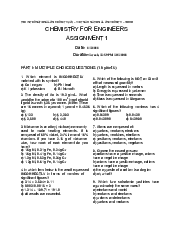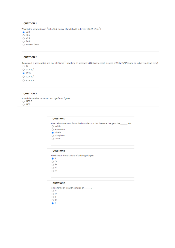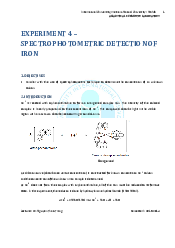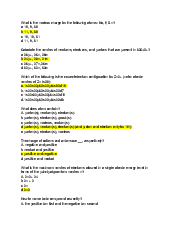




Preview text:
Week 6: Intermolecular Forces
1) What are intermolecular forces? a. Forces within a molecule
b. Attractive forces between molecules
c. Repulsive forces between atoms d. Both a and c
2) Intramolecular forces are responsible for holding:
a. Atoms together in a molecule b. Molecules together c. Ions together d. Neutrons together
3) The inequality "Intermolecular forces < intramolecular forces" implies that:
a. Intermolecular forces are stronger than intramolecular forces
b. Intramolecular forces are stronger than intermolecular forces
c. Both forces are equally strong
d. These forces have no relationship
4) Which of the following is NOT a type of intermolecular force mentioned in the content? a. Dipole-dipole forces b. Ion-ion forces
c. Dispersion forces (van der Waals forces) d. Ion-dipole forces
5) What is the significance of dipole-dipole, dipole-induced dipole, and
dispersion forces in intermolecular interactions? a. Stabilizing the nucleus
b. Bonding atoms within a molecule
c. Influencing the behavior of molecules d. Breaking molecular bonds
6) Ion-dipole forces involve interactions between: a. Two ions b. An ion and a dipole c. Two dipoles d. Two molecules
7) Which intermolecular force is responsible for the temporary shifts in
electron distribution creating temporary dipoles? a. Dipole-dipole forces
b. Dispersion forces (van der Waals forces) c. Ion-dipole forces d. Hydrogen bonding
8) Why is understanding intermolecular forces important in determining physical properties? a. They influence color
b. They affect boiling and melting points
c. They determine molecular weight d. They control radioactivity
9) How do intermolecular forces contribute to the state of matter transitions,
such as boiling and melting? a. They weaken chemical bonds
b. They strengthen intramolecular forces
c. They create additional bonds
d. They affect the kinetic energy of molecules
10) In which scenario would ion-dipole forces be particularly relevant?
a. Interaction between two nonpolar molecules
b. Dissolving an ionic compound in a polar solvent c. Gas phase interactions d. Solid phase interactions Dipole - dipole forces
11) What characterizes dipole-dipole forces?
a. Repulsive forces between polar molecules
b. Attractive forces between nonpolar molecules
c. Attractive forces between polar molecules
d. Repulsive forces within a molecule
12)How does the strength of dipole-dipole forces relate to the dipole moment?
a. The larger the dipole moment, the weaker the force
b. The smaller the dipole moment, the greater the force
c. The larger the dipole moment, the greater the force
d. The dipole moment has no effect on the force
13) In a solid phase, how do molecules tend to align in the context of dipole-dipole forces? a. Randomly with no alignment
b. With like polarities facing each other
c. With opposite polarities facing each other d. Parallel to each other
14) How do polar molecules in liquids behave in relation to dipole-dipole forces?
a. They are not influenced by dipole-dipole forces
b. They align in a random manner
c. They tend to align in a way that maximizes repulsive interactions
d. They tend to align in a way that maximizes attractive interactions on average
15) What is the role of dipole-dipole forces in determining the properties of a substance?
a. They only affect the color of the substance
b. They influence the state of matter transitions
c. They have no impact on physical properties
d. They control the chemical reactivity of the substance Ion-dipole Forces
16) What do ion-dipole forces attract? a. Two ions b. Two polar molecules
c. An ion and a nonpolar molecule d. An ion and a polar molecule
17) In ion-dipole forces, what can the ion be? a. Only a cation b. Only an anion c. Either a cation or an anion
d. Neither a cation nor an anion
18) What is the specific interaction in ion-dipole forces? a. Repulsion between ions
b. Attraction between two nonpolar molecules
c. Attraction between an ion and a polar molecule d. Attraction between two ions
19) What factors influence the strength of ion-dipole interactions?
a. Only the charge of the ion b. Only the size of the ion
c. Both the charge and size of the ion, and the magnitude of the dipole moment and size of the molecule
d. Only the magnitude of the dipole moment
20) How are the charges on cations generally characterized? a. More dispersed b. More concentrated c. Equal to anions d. Unpredictable
21) Why do cations generally have more concentrated charges?
a. Because cations are larger than anions
b. Because cations are usually smaller than anions
c. Because cations and anions have the same size
d. Because cations and anions have equal charge distribution
22) Between a cation and an anion with the same charge magnitude, which
one interacts more strongly with dipoles in ion-dipole forces? a. Cation b. Anion c. Both interact equally
d. Neither interacts with dipoles
23) What does the strength of ion-dipole interaction depend on in terms of the ion and the dipole?
a. Only the charge of the ion b. Only the size of the ion
c. Only the charge and size of the ion
d. Both the charge and size of the ion, and the magnitude of the dipole moment Induced dipole
24) Why is the dipole in the atom or nonpolar molecule referred to as an induced dipole?
a. Because it is artificially created
b. Because it is always present
c. Because its separation of positive and negative charges is due to the proximity of an ion or a polar molecule
d. Because it is a permanent dipole
25) What causes the separation of positive and negative charges in the atom
or nonpolar molecule, leading to an induced dipole?
a. Inherent charge distribution b. External force application
c. Proximity of an ion or a polar molecule d. Temperature changes
26) What is the attractive interaction called between an ion and the induced dipole? a. Ion-dipole interaction b. Dipole-dipole interaction
c. Ion-induced dipole interaction
d. Dipole-induced dipole interaction
27) What is the attractive interaction called between a polar molecule and the induced dipole? a. Ion-dipole interaction b. Dipole-dipole interaction
c. Ion-induced dipole interaction
d. Dipole-induced dipole interaction
28) In the context of induced dipoles, what is the role of the proximity of an ion or a polar molecule? a. It creates repulsion b. It stabilizes the dipole
c. It induces the dipole in the atom or nonpolar molecule
d. It has no effect on the induced dipole Dispersion Forces
29) What factors contribute to the greater polarizability of an atom or molecule? a. Larger atomic mass b. Smaller number of electrons
c. Larger number of electrons and more diffuse electron cloud d. Smaller atomic radius
30) How is a "diffuse electron cloud" in an atom or molecule defined?
a. An electron cloud tightly bound by the nucleus
b. An electron cloud with a small number of electrons
c. An electron cloud with a large number of electrons and spread over an appreciable volume
d. An electron cloud with electrons in a fixed position
31) What effect does a larger number of electrons have on the polarizability of an atom or molecule?
a. It decreases polarizability
b. It has no effect on polarizability c. It increases polarizability
d. It stabilizes the electron cloud The hydrogen bond
32) What is the term used to describe the particularly strong type of
intermolecular attraction involving the hydrogen atom in a polar bond and an electronegative atom? a. Ionic bond b. Hydrogen bond c. Covalent bond d. Van der Waals forces
33) Which atoms are involved in the formation of a hydrogen bond? a. Hydrogen and helium b. Hydrogen and oxygen c. Carbon and nitrogen d. Sodium and chlorine
34) Define a hydrogen bond and provide an example of a polar bond that can
participate in this type of interaction.
a. A bond between two hydrogen atoms; H2
b. An attraction between a hydrogen atom and an electronegative atom; N‒–H
c. A covalent bond between hydrogen and carbon; CH4
d. A bond between two oxygen atoms; O2
35) How does a hydrogen bond differ from a regular dipole-dipole interaction?
a. Hydrogen bonds involve only nonpolar molecules.
b. Hydrogen bonds are stronger and involve specific atoms.
c. Dipole-dipole interactions occur only in solids.
d. Hydrogen bonds require high temperatures to form.
36) Name three elements commonly involved in hydrogen bonding.
a. Carbon, sulfur, phosphorus b. Nitrogen, oxygen, fluorine c. Sodium, potassium, lithium d. Chlorine, bromine, iodine



